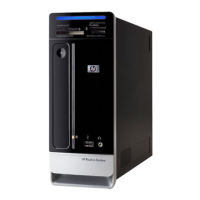Troubleshooting
81
Power
Symptom Problem Solution
PC is not securely connected to
an external power source.
Ensure that cables connecting the PC to the external
power source are plugged in properly.
Monitor is not connected or is
not on.
Connect the monitor to the PC, plug it in, and turn it on.
Line voltage selection switch is
not in the proper position for
your country/region
(115VAC/230VAC).
Set the line voltage selection switch to the correct setting
for your country/region, or refer to the Warranty and
Support Guide to contact Support.
Wall outlet is defective. Test the outlet by connecting a different electrical device
to the outlet.
Wrong memory modules were
used in an upgrade, or
memory modules were
installed in the wrong location.
Reinstall the old memory to return your PC to its original
state. Refer to the Upgrading and Servicing Guide for
instructions.
Hard disk drive is damaged. Press the Help ? button on the keyboard to open the Help
and Support Center, or refer to the Warranty and
Support Guide to contact Support for replacement
details.
PC will not turn on or start.
After an upgrade or repair, the
drive power, data, or power
supply cables may not be
properly connected.
Reseat drive power, data, and power supply cables. See
the Upgrading and Servicing Guide for instructions.
Invalid system disk or
Non-System disk or disk
error message displays
A diskette has been left in the
drive during startup.
When drive activity stops, remove the diskette and press
the spacebar. The PC should start up.
PC appears locked up and
won’t turn off when the On
button is pressed.
PC is not working. Press and hold the On button until the PC turns off.
The unit temperature was
exceeded.
Unit is in an exceedingly hot environment. Let it cool
down.
Ensure PC air vents are not blocked and internal fan is
running. Note that your PC may not have an internal fan.
The unit temperature was
exceeded because the PC was
functioning with the cover or
access panel removed.
Replace cover or access panel, and let the PC cool down
before attempting to turn on power to the PC.
PC powered off
automatically.
Processor or system fan has
failed.
Refer to the Warranty and Support Guide to contact
Support for replacement details. Note that your PC may
not have an internal fan.

